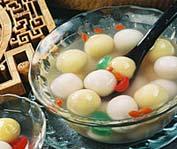
Many people in the south argue that a bowl of savory, pork-stuffed tang yuan is one of the world's best treats.
Many people north of the Yangtze River prefer sweet stuffings for tang yuan, which they call yuan xiao (元宵). It should only be sweet, symbolizing sweetness in life, not savory or salty, which they call heretical.
In fact, the distinction in flavors can be traced back to the Qing Dynasty (1644-1911).
During the reign of the Emperor Kangxi, ba bao yuan xiao (八宝元宵), or eight-treasure glutinous dumplings, was a well-known royal snack. Since then, sweet stuffings became the standard for yuan xiao in northern China. These include sweet sesame, brown sugar, sweet red bean paste and sweet hawthorn.
Meanwhile, tang yuan in southern China developed into a multi-flavored snack. Pork, chicken, vegetables - and, of course, sweet stuffings - have all been used. Some more unusual versions, such as steamed pork with preserved vegetables, are also served these days.
In fact, different flavors are reflected by differently shaped tang yuan, says Chen Wei, head chef of Songhelou Restaurant, a master of tang yuan snacks.
The most traditional sesame-flavored tang yuan is usually round in shape, sweet bean paste tang yuan are oval, while salty and savory ones are round with a pinched point, Chen says. The system has been adopted by most restaurants, which boil the different flavored dumplings separately.
Although tang yuan is considered the special snack of the Lantern Festival, it actually came into existence around a thousand years after the festival itself.
Records show that it first appeared in the Southern Song Dynasty (1127-1279) and originated in Ningbo in east China's Zhejiang Province. The snack resembled today's "Ningbo tang yuan," which are glutinous rice flour dumplings stuffed with black sesame, sugar and lard.
At that time, tang yuan was called fu yuan zi (浮圆子), which means "floating balls." Later in northern China, the name was changed to yuan xiao during the Ming Dynasty (1368-1644).
"The changes of tang yuan are quite complicated," says chef Chen. "While new flavors are being invented, some old types are gradually disappearing, such as brown sugar tang yuan that originated in Suzhou and deep-fried tang yuan in northern China."
